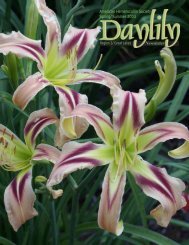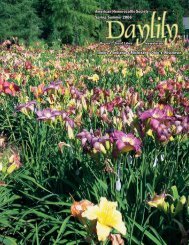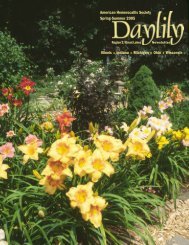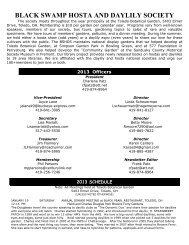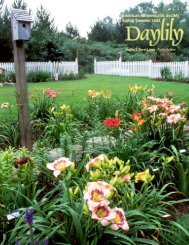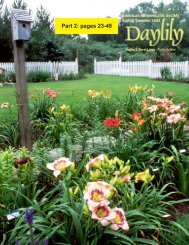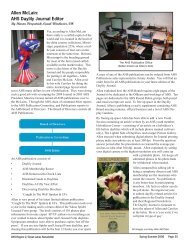Pages - AHS Region 2
Pages - AHS Region 2
Pages - AHS Region 2
Create successful ePaper yourself
Turn your PDF publications into a flip-book with our unique Google optimized e-Paper software.
When H. ‘Gerda Brooker’ was crossed with Curt Hanson’s H. ‘Wind in the Rigging’, a hardier cultivar, the result was a more vigorous plant<br />
and flowers with a heavy substance, like that of the pollen parent. Combining this seedling with a dormant partner, Bob Schwarz’s H.<br />
‘Tuxedo Junction’ has produced some interesting semi-evergreen seedlings and flowers with a very heavy substance. A couple of<br />
examples are shown below. Their colors are complex, and form corresponds to the pinched crispate definition of our Unusual Form guru,<br />
Bob Schwarz.<br />
Left: H. ‘Gerda<br />
Brooker’ X H.<br />
‘Wind in the<br />
Rigging’ (28 7)<br />
Right: (H. ‘Gerda<br />
Brooker’ x H. ‘Wind<br />
in the Rigging’) X<br />
H. ‘Tuxedo<br />
Junction’ (28 7)<br />
Right: (H. ‘Gerda<br />
Brooker’ x H.<br />
‘Wind in the<br />
Rigging’) X H.<br />
‘Tuxedo Junction’<br />
(32 8)<br />
I have begun using daylily offspring from that champion of super tough northern daylilies, Melanie<br />
Mason. Her H. ‘Astral Voyager’ produces some delightful kids that are both hardy and vigorous, like<br />
the cockerel form shown to the left.<br />
(H. ‘Gerda Brooker’ x H. ‘Blue-<br />
Eyed Guy’) X H. ‘Astral<br />
Voyager’ (30 6)<br />
Third: Adapting Tender Tetraploid Spiders and Unusual Form Daylilies to the North<br />
Pat Stamile is far ahead of everyone else in creating tetraploid spiders and large exotics, so I get his<br />
collection of these each year. His tender evergreens probably do as well or better here than most<br />
Florida daylilies. I’ll use the example of his 2001 introductions as they have been here long enough to<br />
be evaluated fairly. Of the nine cultivars, four are fairly vigorous and show good bloom: H. ‘Igor’, H.<br />
‘Octopus Hugs’, H. ‘Lurch’ and H. ‘Purple People Eater’. Two hold their own but show little increase:<br />
H. ‘Wings on High’ and H. ‘His Highness.’ Three have dwindled: H. ‘Navajo Talisman’, H. ‘Inky<br />
Fingers’ and H. ‘Lavender Arrowhead’.<br />
Seedlings from some of these, crossed with dormant, hardy stock, are shown below. The first three are<br />
crosses with cultivars introduced by the late Richard Webster, who greatly furthered the development<br />
of hardy tetraploids. These seedlings have had their second season of bloom and appear to be on<br />
their way as strong northern plants.<br />
Left:<br />
H. ‘Fuchsia<br />
Fashion’ X H. ‘Inky<br />
Fingers’ (36 8)<br />
Left:<br />
H. ‘Red Suspenders’<br />
X H. ‘Royal<br />
Celebration’ (38 9)<br />
Right: H. ‘Red<br />
Suspenders’ X H. ‘Web<br />
Browser’ (36 9)<br />
The three seedlings, left and below, have only had one bloom season and will be watched carefully for<br />
hardiness. The first two are crosses of dormants by Pat Roberts and Bob Schwarz with evergreens<br />
from Stamile. The last seedling, the gold spider, is the product of two very hardy evergreens from<br />
Stamile and Luddy Lambertson.<br />
Left: H. ‘Wings on High’ X<br />
H. ‘Ondine’ (36 8)<br />
Middle: H. ‘Star of India’ X<br />
H. ‘Navajo Talisman’ (38 8)<br />
Right: H. ‘Octopus Hugs’<br />
X H. ‘On Silken Thread’<br />
(40 10)<br />
<strong>AHS</strong> <strong>Region</strong> 2/Great Lakes Newsletter<br />
Fall 2005 - Winter 2006 Page 13



